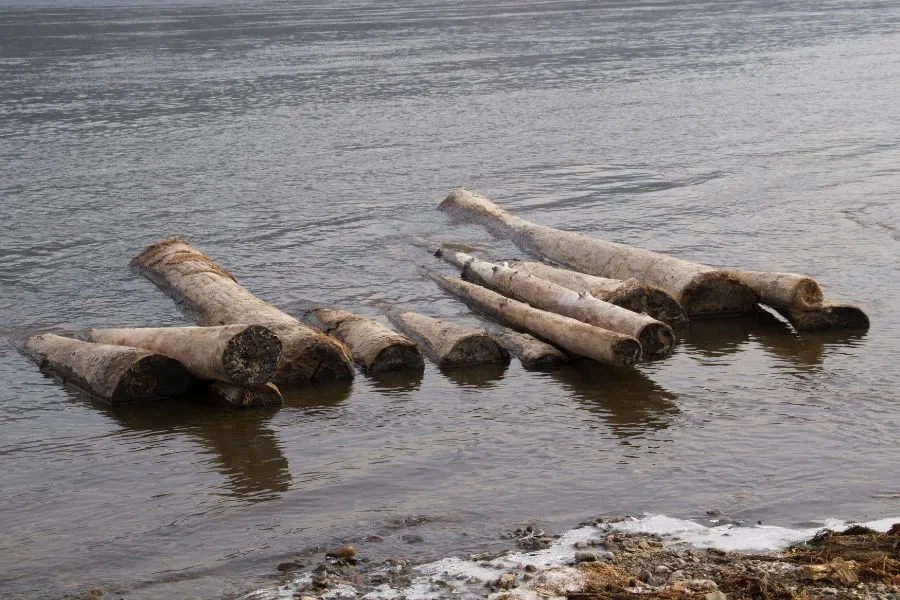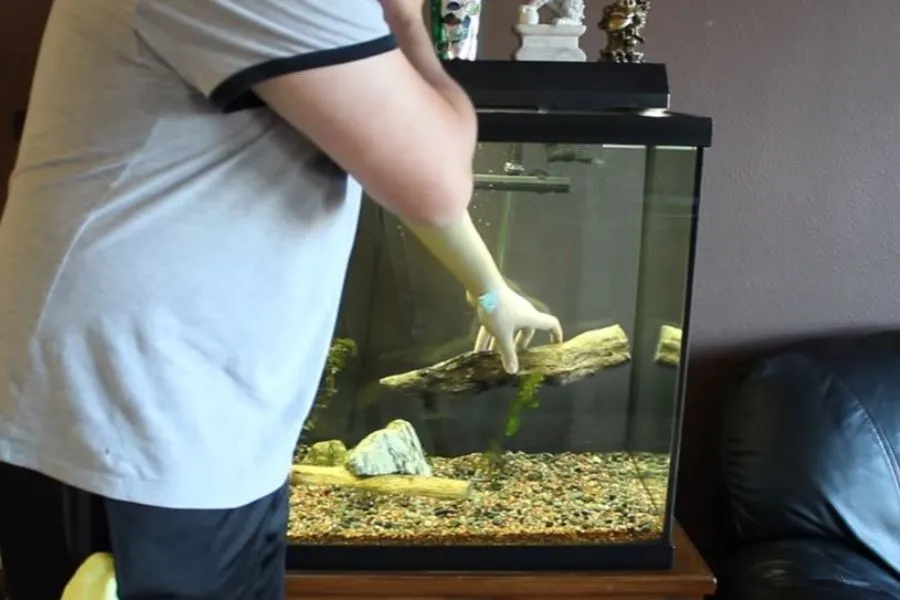Generally, most people decorate their aquariums with plants and rocks. Some also use driftwood to do so as well. However, they may face a major issue where the driftwood does not sink into the aquarium but floats. Why isn’t your driftwood sinking?
Generally, floating driftwood may result from the driftwood trapping air bubbles inside the wood. You may do many things to help the wood to sink, such as submerging and boiling it. You may add weight to it to make it sink or glue it down to the aquarium.

This article discusses why your driftwood is not sinking and if there are ways to make it sink. We also discuss issues such as whether you must make your wood sink and will driftwood rot in the aquarium.
Should Your Driftwood Sink?
You do not need to sink your driftwood, although conventionally, most driftwood is sunk into the base of the aquarium. First is because it is aesthetically nicer to do so; second, sunk driftwood can become a playground for fishes to swim and hide in.
Commonly, many fish keepers purchase driftwood to be used as decoration for their aquarium. The usual practice is to sink the driftwood to the base of the aquarium and then decorate the aquarium with rocks, plants, and many more.

Generally, driftwood is sunk into the base of the aquarium because it is more aesthetically pleasing. The wood looks more naturally sunk than floating in the aquarium. Although it is not aesthetically pleasing, you can leave your driftwood to float. It is definitely out of the norm for many fish keepers.
Driftwoods are usually sunk to the base of the aquarium as it provides a nice playground for fish. Many fishes, especially small ones, enjoy swimming around this driftwood to play and hide. These fishes usually rarely swim to the surface unless to feed.
Why Isn’t My Driftwood Sinking?
Your driftwood may not be sinking because of the air bubbles that have formed in the driftwood. These air bubbles may have formed during the breaking down process of the wood. Aside from that, some wood types are more prone to floating, as they are less dense.
Driftwood pieces may not sink because of trapped air bubbles within the wood. It is important to remember that these wood pieces are essentially rotting pieces of wood, meaning they are being deformed.

During the deforming process, some parts of the wood may form air pockets, which trap air. As a result, when you place these driftwood pieces into the water, it floats rather than sink.
Another possible reason is that the wood type may, in some ways, affect whether the driftwood sinks or floats. If the wood type is lighter and less dense, the likelihood of the wood floating would be much higher.
In general, denser driftwood such as Malaysian or Mopani may sink better. If they float, you may not need to do too many things to make them sink.
How To Make Driftwood Sink?
To make driftwood sink, you may let it happen naturally by soaking it or force it faster by boiling it. You can also consider adding additional weights to force the wood to sink, such as tying tiles or using a slate to hold the wood down. You may also glue the wood to the base of your aquarium to prevent it from floating.
You may try to sink your driftwood by doing several things. These options may depend on your patience, energy, and general preference.
Get Pre-Soaked Driftwood: The easiest way to spare yourself the trouble of dealing with floating driftwood is to get driftwood that is confirmed to sink. These are pre-soaked driftwood and should be purchasable at your local aquarium shop.
Many aquarium shops realize the demand for driftwood, so many actively source driftwood and then soak it themselves to make it sink before selling it to others. You can purchase this pre-soaked driftwood and immediately get driftwood that sinks.
Soaking: If you have gotten driftwood, and it does not sink, you can start by soaking it yourself. For many driftwoods, consistent soaking may eventually cause them to sink naturally.
This is because when you soak the wood, water may be absorbed by the wood, and this moisture and water eventually fill these air pockets and push out the air. Once enough air bubbles are removed, the wood will naturally sink.
If you intend to sock the wood, consider doing it separately and not in the aquarium itself. This is because raw driftwood may, at times, leech out tannins when soaked, which may cause your aquarium water to look brackish and cloudy. Excessive tannins may also harm your fish.
Boiling: If you do not have the patience to wait, you can go for a more radical solution: boil it. When you boil your driftwood, you hasten and speed up the process of breaking the air bubbles and help push out the tannins from the driftwood faster.
When you boil your driftwood, you are likely also sterilizing the wood by killing any microorganism, spore, or possible fungi that is hiding inside the wood. This may spare you from the future headache of dealing with algae or water infection.
To boil your driftwood, prepare a large pot, tie some rock or metal objects to the wood, and put the wood inside the pot. Boil for 30-120 minutes.
Drill Some Holes: If soaking and boiling still do not help the driftwood to sink, perhaps you may consider a physical intervention by drilling a few holes through the driftwood.
This method works by breaking down the floating surface of the driftwood, reducing the driftwood’s ability to float. As a result, your driftwood may just lose enough buoyancy that it sinks.
If you implement this method, simply drill a few holes over the thickest parts of the wood. Drill in areas where you can easily hide later with rocks or plants. You also do not want to over-drill, as artificial holes can be aesthetically odd on a natural piece of driftwood.
Using Tiles: If the wood still floats, you can consider using additional weights to make the driftwood sink. You can do so by using tiles. Start by drilling two small holes over a piece of tile. Then use a steel wire and loop the wire through the holes.
Now tie the tile with your driftwood. The best position would be at the center of the driftwood. Once the driftwood has settled inside the aquarium, cover up the tiles with rocks and some plants. This should keep the wood inside for a long time, and you may just find out that the wood sinks by itself after some time.
Weighing Down With Rocks: Some may not like using a tile, as it is unnatural. If you are in the same camp, you can consider tying some rock with the driftwood.
The additional weight should help the wood to sink. Plus, since the weight is a rock and not a tile, it appears more natural and can blend in better with the other rocks and plants in the aquarium.
Gluing It Down: You can use glue to keep the driftwood in place at the bottom of the aquarium. This method works best on smaller pieces of wood because things could get tricky if you try to use it on bigger pieces.
But remember that aquarium glue is hard to get off and can make your driftwood dirty and hard to clean.
Use super glue or cyanoacrylate gel for the best experience and to avoid making any dangerous chemicals in the water. When super glue gets in contact with water, it stops working and sticks to whatever it is stuck to.
Aquarium glue is the best because it is made to work best in water. Your fish can also eat this glue. The glue will keep everything in place as long as the surface of the water tank is clean and the driftwood is good.
Entangling It With Plants: If other methods so far are done to encourage the driftwood to sink, this method prevents it from floating. You can also tie up plants around the driftwood to prevent it from floating.
Many plants may have enough weight on their own to hang on to driftwood and prevent it from floating. This approach is all-natural, without using glue or tiles. This might be more aesthetically pleasing for your aquarium as well.
Will Driftwood Rot In Aquarium?
Driftwood will rot in the aquarium, although, in general, the pace is very slow. If your driftwood rotates faster than expected, it may signify something more serious. Some driftwood turns white or black when rotting.
Driftwood is a piece of rotting wood. Which means it will rot wherever you put it. The thing with driftwood, however, is that they deteriorate very slowly and take a long time to disintegrate.
However, notice your driftwood rotting faster than expected. That may be a sign that your driftwood is being infected with something. Driftwood that turns black may be disintegrating or could be infected by Black Beard algae. Driftwood that turns white may have bacteria or fungi growth.
If you see these signs on your driftwood, you need to start investigating the reason and attend to it immediately.




